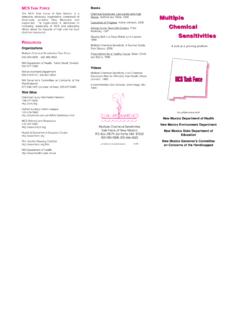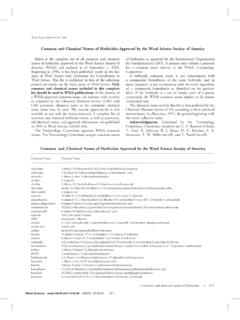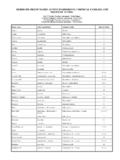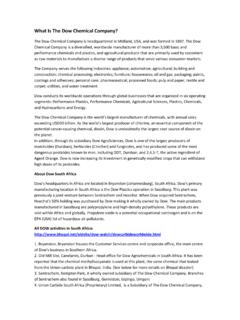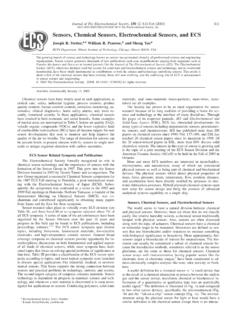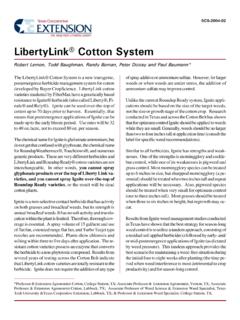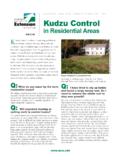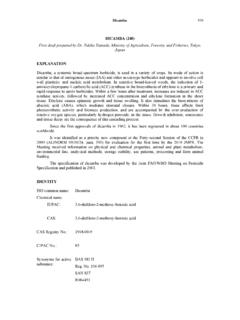Transcription of Making Your Environment Safe - Multiple chemical sensitivity
1 Excerpted from: Gibson, (2006). Multiple chemical sensitivity : A Survival Guide. Churchville, VA: Earthrive Books. Chapter Four ------------------------------ Making your Environment safe If you are newly aware of having sensitivities, or are living in a home that still needs some cleanup, probably the most important thing you can do to protect yourself is to reduce your chemical and electrical exposures. By Making a safe haven for yourself, you will suffer fewer reactions and have a safe place to clear out your body from exposures that occur outside of your home.
2 This chapter will help you quickly clean up your home Environment so that you can function better and avoid the tendency to develop more sensitivities. The chapter does not cover every safe product available, but you can go for quite a while using a few safe cleaning products, personal care items, and clothes. (See Appendix B for product sources.) When you feel better and have the time, you can explore a wider variety of options. Keep in mind there are hundreds of products on the market that are designed more to make money than to help you with your health, regardless of what advertisers say.
3 Michael Lax (1998) warns about entrepreneurial activities without patient welfare in mind (p. 734). For example, any product rubbed into the skin is absorbed and can be detected in the blood in minutes. (This is how nicotine and estrogen patches work.) Therefore, you need to exercise particular caution with personal care products. Be sure to investigate all products before purchasing them. The rule Buyer beware applies as much to health food stores and alternative mail-order catalogs as it does to mainstream products. In fact, health food stores regularly offer products that are nearly as toxic as those in grocery and other stores.
4 Larger personal care and health food companies are buying out the smaller ones, and consumers are fooled into thinking that they are buying clean products when they are not. It is very difficult to market truly safe products because most very clean products are made by small companies, have a limited shelf life, and the ingredients must be purchased in small quantities. Because distributors want to earn a high profit, it is virtually impossible for most small companies to market through the usual distributor channels. Note: When new products are introduced in distributors catalogs, no ingredients are listed and busy buyers may assume products are natural.
5 Products with toxic ingredients commonly are given names with earth and natural in them and are marketed as though they were chemically or environmentally safe . This practice is called green-washing. My friends who own a health food store learn the ingredients in their products the same way we do by walking around their store and reading labels. In the Home: The Big Stuff Some of the accommodations that are needed to make a home chemically safe may be so extensive and may involve such costly structural change that it becomes necessary to move.
6 You will have to assess your location and house structure before you can decide if your home is safe enough not to further jeopardize your health. Can This House Be Saved? The following questions may help you to sort out what works from what doesn t: Outside your Home Is your home located near polluting traffic or industry fumes that will make it impossible to go outside or to open your windows, even if the inside of the house is made safer? If you are gas-sensitive, are you subject to neighbors heating fuel smells, gas from propane cookers or dryers, or fumes from neighbors who do their own auto work?
7 Do close neighbors use lawn treatments that will expose you to dangerous herbicides and pesticides? Does the local county do aerial spraying for mosquitoes, gypsy moths, or other insects? Is your home downwind or downstream from any large polluting agencies most of the time? (Wind directions vary, but they have common patterns.) Is your house near large sources of EMFs? That is, are there high-tension electrical wires or power stations close by? Where is the closest cell phone tower? You can acquire a meter to measure magnetic fields for both outside and inside sources.
8 (See Appendix B for product sources.) Although there are products such as special paints and other materials that are said to screen or filter EMFs, it is easier not to enter into a situation where you will have to attempt these difficult measures. Even if you do not think that you are personally sensitive to EMFs, the health effects from these exposures appear to be harmful to everyone. Problematic can be cell phone towers, radio wave towers, and other sources of EMFs. You may need to find where the closest of these facilities is located and decide whether or not it is a safe distance.
9 However, more and more of these facilities are being located in residential areas with minimal input from the community. So, even if your home is presently not affected, it could be in the future. The towers are being disguised as trees and cacti, Making it difficult to know their locations. People very knowledgeable about electromagnetic sensitivities believe that you should never live within a mile of a radio or cell phone tower. Farther is better. It may be that four miles is about as safe of a distance as you will be able to find.
10 R. Bruce McCreary believes that all people with MCS or ES should own a meter with which to measure their Environment in order to lower their daily exposures and prevent the development of or worsening of ES. He does not endorse denial as a preventative for ES, as a number of people have ignored this issue and developed severe ES as a result. He also claims ES makes MCS seem like a walk in the park. (See Appendix B for Bruce s suggested EMF meters.) Inside your Home Is your home heated with gas or oil? If so, is the cost of a changeover to electric heating worth it as the house is otherwise safe ?

